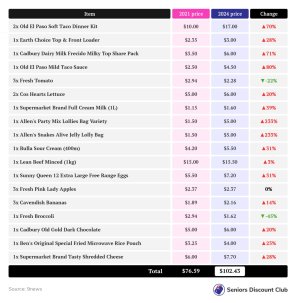Your grocery bill has skyrocketed for the past years thanks to these factors
By
Danielle F.
- Replies 33
The cost of living is a topic on everyone's lips these days and for a good reason.
Every time we check out at supermarkets, the total on the screen is a little higher than the last.
A recent analysis unpacked this uneasy feeling, revealing a staggering increase over the past three years.
9News found that based on an itemised receipt from 2021, a basket of 18 everyday items then would set you back $76.59.
Fast forward to today, buying the same items, which include staples like minced beef and vegetables, in the same shop would cost you $102.43.
That's an extra $25.84 for the same products.
While we expect some fluctuation due to specials and seasonal changes, these figures indicate a broader trend hitting consumers.
The price hikes aren't uniform across the board.
Non-perishable items like taco kits have seen some of the most significant increases, jumping from $10 to $17—a 70 per cent rise.
Meanwhile, a sweet treat like a bag of lollies has more than tripled in price, from $1.50 to $5.
Even the humble Freddo frog isn't immune, with a packet of Milky Top Freddos leaping from $3.50 to $6.
However, it's not all bad news.
Some fresh produce, like broccoli and tomatoes, has decreased in price.
Apples have managed to stay the same price, defying the trend.
This could be a silver lining for those trying to maintain a healthy diet on a budget.
So, what's driving these price increases?
A myriad of factors are at play.
External elements such as nature, growing conditions, and logistics all impact the cost of produce—but there's more to it than just the weather.
The cost of chocolate, for example, has risen due to high demand and a supply deficit.
The broader economic landscape is also a factor.
Inflation affects nearly every aspect of our lives, from groceries to utilities, and wages are not keeping up.
Interest rates are rising, with 13 increases in 15 months since May 2022, squeezing household budgets further.
Farmers are feeling the pinch, too.
Many are struggling to stay profitable as the purchase price for their produce is often too low to cover costs.
Some were forced to close business, with an Alice Springs grape grower sharing that it was 'impossible' to meet supermarket standards and turn a profit.
The Senate inquiry into these issues has heard that supermarkets may be wielding too much power, potentially leading to a 'societal breakdown', Greens Senator Nick McKim said.
There are calls for reviewing the Food and Grocery Code of Conduct and imposing hefty fines on supermarkets mistreating suppliers.
Another factor to consider is 'shrinkflation’, where the size of products reduces, but prices stay the same or increase.
Consumer advocacy group CHOICE has identified ten products affected by shrinkflation so far—and that’s just for the first quarter of the year.
With all these factors in play, it’s important to be mindful of how and where you spend your money.
Keep an eye out for specials, consider buying in bulk, and maybe even try growing some of your veggies if you have the space.

Have these price increases affected your shopping habits? Have you found any clever ways to stretch your dollar further? Share your tips with us in the comments below.
Every time we check out at supermarkets, the total on the screen is a little higher than the last.
A recent analysis unpacked this uneasy feeling, revealing a staggering increase over the past three years.
9News found that based on an itemised receipt from 2021, a basket of 18 everyday items then would set you back $76.59.
Fast forward to today, buying the same items, which include staples like minced beef and vegetables, in the same shop would cost you $102.43.
That's an extra $25.84 for the same products.
While we expect some fluctuation due to specials and seasonal changes, these figures indicate a broader trend hitting consumers.
The price hikes aren't uniform across the board.
Non-perishable items like taco kits have seen some of the most significant increases, jumping from $10 to $17—a 70 per cent rise.
Meanwhile, a sweet treat like a bag of lollies has more than tripled in price, from $1.50 to $5.
Even the humble Freddo frog isn't immune, with a packet of Milky Top Freddos leaping from $3.50 to $6.
However, it's not all bad news.
Some fresh produce, like broccoli and tomatoes, has decreased in price.
Apples have managed to stay the same price, defying the trend.
This could be a silver lining for those trying to maintain a healthy diet on a budget.
So, what's driving these price increases?
A myriad of factors are at play.
External elements such as nature, growing conditions, and logistics all impact the cost of produce—but there's more to it than just the weather.
The cost of chocolate, for example, has risen due to high demand and a supply deficit.
The broader economic landscape is also a factor.
Inflation affects nearly every aspect of our lives, from groceries to utilities, and wages are not keeping up.
Interest rates are rising, with 13 increases in 15 months since May 2022, squeezing household budgets further.
Farmers are feeling the pinch, too.
Many are struggling to stay profitable as the purchase price for their produce is often too low to cover costs.
Some were forced to close business, with an Alice Springs grape grower sharing that it was 'impossible' to meet supermarket standards and turn a profit.
The Senate inquiry into these issues has heard that supermarkets may be wielding too much power, potentially leading to a 'societal breakdown', Greens Senator Nick McKim said.
There are calls for reviewing the Food and Grocery Code of Conduct and imposing hefty fines on supermarkets mistreating suppliers.
Another factor to consider is 'shrinkflation’, where the size of products reduces, but prices stay the same or increase.
Consumer advocacy group CHOICE has identified ten products affected by shrinkflation so far—and that’s just for the first quarter of the year.
With all these factors in play, it’s important to be mindful of how and where you spend your money.
Keep an eye out for specials, consider buying in bulk, and maybe even try growing some of your veggies if you have the space.
Key Takeaways
- Shopping costs have risen by 33 per cent in nearly three years, with Australians paying more for everyday items during the cost-of-living crisis.
- The price increase has particularly affected non-perishable items, with some items like taco kits and bags of lollies increasing by 70 per cent and 233 per cent, respectively.
- Despite the increase, some fresh fruits and vegetables have either stayed the same in price or decreased.
- The issue of shrinkflation is also highlighted, affecting Australian consumers who are already facing financial pressure due to rising inflation.
Last edited:








